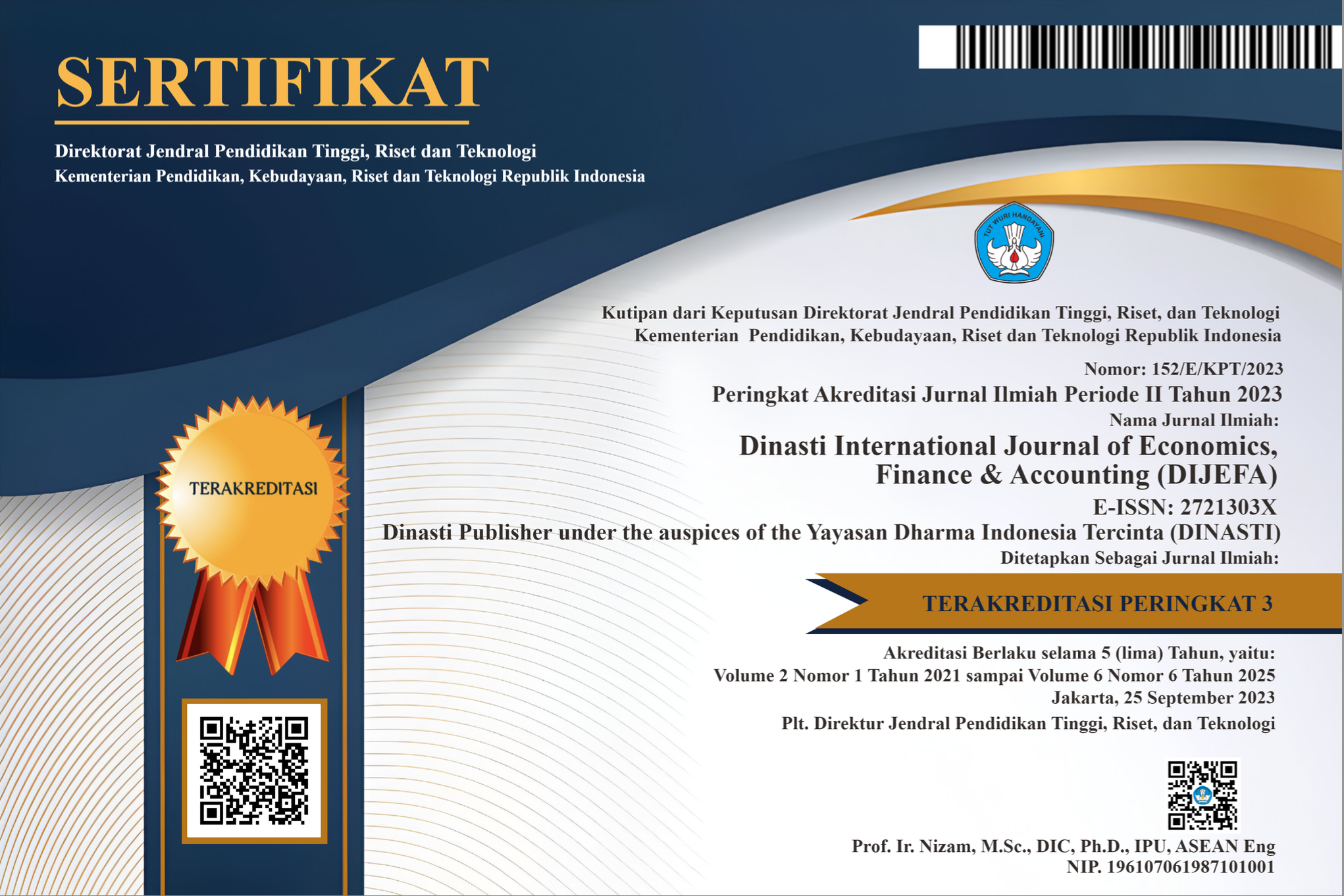The Fraud Hexagon Model and Corporate Governance Moderation in the Investigation of Financial Statement Fraud
DOI:
https://doi.org/10.38035/dijefa.v5i2.2547Keywords:
Board Effectiveness, Collusion, Fraud, Hexagon ModelAbstract
Financial statement fraud is fraud committed by management in the form of misstatements of financial information that can harm other parties for personal or certain group interests. In recent years, the theory of financial statement fraud has developed, starting with the triangle, diamond, pentagon, and finally hexagon theories. The hexagon theory is a development of the previous theory with the components of stimulus, capability, collusion, opportunity, rationalization, and ego. The effect of the Hexagon Theory component on financial statement fraud is investigated in this study, with corporate governance serving as a moderating variable. This quantitative research was developed by observing 235 sets of data obtained from annual reports of public companies in the property and real estate sectors listed on the Indonesia Stock Exchange for the 2016–2020 period and analyzing them using a panel data regression model processed with the EViews program. The results of the study prove that only the stimulus component, as measured by financial targets, and external pressure affect financial statement fraud. Furthermore, corporate governance has been shown to moderate the relationship between financial statement fraud and stimulus, opportunity, rationalization, and ego.
References
ACFE. (2020). Survei Fraud Indonesia 2019. Jakarta: ACFE Indonesia Chapter.
Achmad, T., Ghozali, I., & Pamungkas, I. D. (2022). Hexagon Fraud: Detection of Fraudulent Financial Reporting inState-Owned Enterprises Indonesia. Economies, 10(1), 1-16. doi: https://doi.org/10.3390/economies10010013
Aghghaleh, S. F., Mohamed, Z. M., & Rahmat, M. M. (2016). Detecting Financial Statement Frauds in Malaysia: Comparing the Abilities of Beneish and Dechow Models. Asian Journal of Accounting and Governance, 7, 57–65. doi:http://dx.doi.org/10.17576/AJAG-2016-07-05
Agusputri, H., & Sofie, S. (2019). Faktor-faktor yang berpengaruh terhadap fraudulent financial reporting dengan menggunakan analisis fraud pentagon. Jurnal Informasi, Perpajakan, Akuntansi, dan Keuangan Publik, 105–124.
Al-Musali, M. A., & Ismail, K. N. (2015). Board diversity and intellectual capital performance: the moderating role of the effectiveness of board meetings. Accounting Research Journal, 28(3), 1-29. doi:http://dx.doi.org/10.1108/ARJ-01-2014-0006
Anggraini, W. R., & Suryani, A. W. (2021). Fraudulent financial reporting through the lens of the fraud pentagon theory. Jurnal Akuntansi Aktual, 8(1), 1-12. doi:http://dx.doi.org/10.17977/um004v8i12021p001
Annisya, M., Lindrianasari, & Asmaranti, Y. (2016). Pendeteksian Kecurangan Laporan Keuangan Meggunakan Fraud Diamond. Jurnal Bisnis dan Ekonomi, 23(1), 72-89.
Arum, E. D., & Wahyudi, I. (2020). Fraudulent Financial Reporting Detection in Banking Sector: Evidence from Indonesia. International Journal of Psychosocial Rehabilitation(Conference Special Issue), 199-211. doi:https://10.37200/V24SI2/15600
Budiyanto, W., & Puspawati, D. (2022). Analisis Fraud Hexagon Dalam Mendeteksi Financial Statement Fraud. 3rd National Conference on Accounting and Fraud Auditing. 3. Jakarta: Fakultas Ekonomi dan Bisnis Universitas Trilogi. Retrieved from https://trilogi.ac.id/journal/ks/index.php/EPAKT/article/view/1213
Cressey, D. (1953). Other People’s Money: A Study in the Social Psycology of Embezzlement. The American Journal of Sociology, 2(3).
Dalnial, H., Kamaluddin, A., Sanusi, Z. M., & Khairuddin, K. S. (2014). Accountability in Financial Reporting: Detecting Fraudulent Firms. Procedia - Social and Behavioral Sciences, 145, 61-69. doi:https://doi.org/10.1016/j.sbspro.2014.06.011
Deliana, Rahman, A., & Oktalia, R. R. (2022). FRAUD DETECTION OF FINANCIAL STATEMENTS WITH DIAMOND FRAUD ANALYSIS. Jurnal ASET (Akuntansi Riset), 14(1), 33-42. doi:https://DOI : 10.17509/jurnal aset.v14i1.43650
Devi, P. N., Widanaputra, A. A., Budiasih, I. G., & Rasmini, N. K. (2021). The Effect of Fraud Pentagon Theory on Financial Statements: Empirical Evidence from Indonesia. Journal of Asian Finance, Economics and Business, 8(3), 1163–1169. doi:https://doi:10.13106/jafeb
Faradiza, S. A. (2018). Fraud Pentagon dan Kecurangan Laporan Keuangan. EkBis: Jurnal Ekonomi dan Bisnis, 2(1), 1–22.
Handoko, B. L. (2021). Fraud Hexagon dalam Mendeteksi Financial Statement Fraud Perusahaan Perbankan di Indonesia. Jurnal Kajian Akuntansi, 5(2), 176-192. doi: http://dx.doi.org/10.33603/jka.v5i2.5101
Herdiana, R., & Sari, S. P. (2018). Analisis Fraud Diamond dalam Mendeteksi Kecurangan Laporan Keuangan (Studi Empiris pada Perusahaan Manufaktur yang Terdaftar di Bursa Efek Indonesia Periode 2015- 2017. Prosiding Seminar Nasional & Call for Paper III, Fakultas Ekonomi, Universitas Muhammadiyah Ponorogo, 402-420.
Hsu, Y.-L., & Yang, Y.-C. (2022). Corporate governance and financial reporting quality during the COVID-19 pandemic. Finance Research Letters, 45, 1 - 13. doi:https://doi.org/10.1016/j.frl.2022.102778
IAI. (2020). Kerangka Konseptual Laporan Keuangan. Jakarta: Ikatan Akuntan Indonesia.
In'airat, M. (2015). The Role of Corporate Governance in Fraud Reduction - A Perception Study in the Saudi Arabia Business Environment. Journal of Accounting and Finance , 15(2), 119-128.
Kieso, D. E., Weygandt, J. J., & Warfield, T. D. (2012). Intermediate Accounting. 14th Edition. USA: John Wiley & Sons Inc.
Kyei, S. M., Werner, K., & Appiah, K. O. (2022). Board meetings and bank performance in Africa. Cogent Business & Management, 9(2034235), 1-16. doi:https://doi.org/10.1080/23311975.2022.2034235
Larum, K., Zuhroh, D., & Subiyantoro, E. (2021). Fraudlent Financial Reporting: Menguji Potensi Kecurangan Pelaporan Keuangan dengan Menggunakan Teori Fraud Hexagon. Accounting and Financial Review, 4(1), 82-94. doi:https://doi.org/10.26905/afr.v4i1.5957
Md Nasir, N. .., & Hashim, H. A. (2021). Corporate governance performance and financial statement fraud: evidence from Malaysia. Journal of Financial Crime, 28(3), 797-809.
Nindito, M. (2018). Financial Statement Fraud: Perspective of The Pentagon Fraud Model in Indonesia. Academy of Accounting and Financial Studies Journal, 22(3), 1-9. Retrieved from https://www.abacademies.org/articles/Financial-Statement-Fraud-Perspective-of-the-Pentagon-Fraud-Model-in-Indonesia-1528-2635-22-3-199.pdf
Nugroho, D. S., & Diyanty, V. (2022). Hexagon Fraud in Fraudulent Financial Statements: The Moderating Role of Audit Committee. Jurnal Akuntansi dan Keuangan Indonesia, 19(1), 46-67. doi:DOI: 10.21002/jaki.2022.03
Putra, A. R., & Kusnoegroho, Y. A. (2021). Pengujian Fraud Pentagon Dalam Mendeteksi Kecurangan Laporan Keuangan. AFRE Accounting and Financial Review, 4(2), 172-185. doi: https://doi.org/10.26905/afr.v4i2.6269
Romney, M. B., & Steinbart, P. J. (2018). Accounting Information Systems (14th Edition ed.). England: Pearson.
Rukmana, H. S. (2018). Pentagon Fraud Affect on Financial Statement Fraud and Firm Value. South East Asia Journal of Contemporary Business, 16(5), 118–122.
Sabatian, Z., & Hutabarat, F. M. (2020). The Effect of Fraud Triangle in Detecting Financial Statement Fraud. Jurnal Akuntansi, 10(3), 231-244. doi:https://doi.org/10.33369/j.akuntansi.10.3.231-244
Sandria, F. (2021, Juli 27). CNBC Indonesia. Retrieved from www.cnbcindonesia.com: https://www.cnbcindonesia.com/market/20210726191301-17-263827/deretan-skandal-lapkeu-di-pasar-saham-ri-indofarma-hanson/3
Sari, S. P., & Nugroho, N. K. (2020). Financial Statements Fraud dengan Pendekatan Vousinas Fraud Hexagon Model: Tinjauan pada Perusahaan Terbuka di Indonesia. Proceedings of 1st Annual Conference on IHTIFAZ: Islamic Economics, Finance, and Banking (ACI-IJIEFB), 409-430.
Schilit, H. M., Perler, J., & Engelhart, Y. (2018). Financial Shenanigans, Fourth Edition: How to Detect Accounting Gimmicks and Fraud in Financial Reports. New York: McGraw-Hill Education.
Septriyani, Y., & Handayani, D. (2018). Mendeteksi kecurangan laporan keuangan dengan Analisis fraud pentagon. Jurnal Akuntansi, Keuangan dan Bisnis,, 11-23.
Siddiq, F. R., & Suseno, A. E. (2019). Fraud pentagon theory dalam financial statement fraud pada perusahaan terdaftar di Jakarta Islamic Index (JII) Periode 2014-2017 (Perspektif F-Score Model). Jurnal Nusantara Aplikasi Manajemen Bisnis, 128–138.
Siddiq, F. R., Achyani, F., & Zulfikar. (2017). Fraud pentagon dalam mendeteksi financial statement fraud. Seminar Nasional dan The 4 th Call for Syariah Paper.
Sihombing, K. S., & Rahardjo, S. N. (2014). Analisis Fraud Diamond dalam Mendeteksi Financial Statement Fraud: Studi Empiris pada Perusahaan Manufaktur yang Terdaftar di Bursa Efek Indonesia (BEI) Tahun 2010-2012. Diponegoro Journal of Accounting , Vol. 03 .
Skousen, C. J., Smith, K. R., & Wright, C. J. (2009). Detecting and predicting financial statement fraud?: The effectivenes of the fraud triangle and SAS No 99. Corporate Corporate Governance and Firm Performance, 13, 53-81. doi:https://doi.org/10.1108/S1569-3732(2009)0000013005
Skousen, C. J., Smith, K. R., & Wright, C. J. (2011). Detecting and Predicting Financial Statement Fraud: The Effectiveness of the Fraud Triangle and SAS No. 99. SSRN Electronic Journal.
Sunaryo, K., Astuti, S., & Zuhrotun. (2019). The role of risk management and good governance to detect fraud . Journal of Contemporary Accounting, 1(1), 38-46.
Tessa, C., & Harto, P. (2016). Pengujian teori fraud pentagon pada sektor keuangan dan perbankan di Indonesia. Simposium Nasional Akuntansi. IAI KAPd.
Tiffani, L., & Marfuah, M. (2015). Deteksi Financial Statement Fraud dengan Analisis Fraud Triangle pada Perusahaan Manufaktur yang Terdaftar di Bursa Efek Indonesia. Jurnal Akuntansi dan Auditing Indonesia, 19(2), 112-125. doi:https://doi.org/10.20885/jaai.vol19.iss2.art3
Ulfah, M., Nuraina, E., & Wijaya, A. L. (2017). Pengaruh Fraud Pentagon dalam Mendeteksi Fraudulent Financial Reporting (Studi Empiris pada Perbankan di Indonesia yang Terdaftar di BEI). The 9th Forum Ilmiah Pendidikan Akuntansi (FIPA), 5(7), 399–417.
Vousinas, G. L. (2018). Elaborating on the Theory of Fraud. New Theoretical Extensions. SSRN Electronic Journal, 1-17. doi:http://dx.doi.org/10.2139/ssrn.3163337
Vousinas, G. L. (2019). Advancing Theory of Fraud: The S.C.O.R.E. Model. Journal of Financial Crime, 26(1), 372–381. doi: https://doi.org/10.1108/JFC-12-2017-0128
Wolfe, D. T., & Hermanson, D. R. (2004). The Fraud Diamond: Considering The Four Element of Fraud. CPA Journal, 74(12), 38-42.
Yendrawati, R., Aulia, H., & Prabowo, H. (2019). Detecting the Likelihood of Fraudulent Financial Reporting: An Analysis of Fraud Diamond. Asia-Pacific Management Accounting Journal, 14(1), 43-68. Retrieved from https://ir.uitm.edu.my/id/eprint/29364/1/29364.pdf
Yusrianti, H., Ghozali, I., Yuyetta, E., Aryanto, & Meirawati, E. (2020). Financial Statement Fraud Risk Factors of Fraud Triangle: Evidence From Indonesia. International Journal of Financial Research, 11(4), 36-51. doi:https://doi.org/10.5430/ijfr.v11n4p36
Downloads
Published
How to Cite
Issue
Section
License
Copyright (c) 2024 Enggar Diah Puspa Arum, Ilham Wahyudi

This work is licensed under a Creative Commons Attribution 4.0 International License.
Authors who publish their manuscripts in this journal agree to the following conditions:
- The copyright on each article belongs to the author(s).
- The author acknowledges that the Dinasti International Journal of Economics, Finance & Accounting (DIJEFA) has the right to be the first to publish with a Creative Commons Attribution 4.0 International license (Attribution 4.0 International (CC BY 4.0).
- Authors can submit articles separately, arrange for the non-exclusive distribution of manuscripts that have been published in this journal into other versions (e.g., sent to the author's institutional repository, publication into books, etc.), by acknowledging that the manuscript has been published for the first time in the Dinasti International Journal of Economics, Finance & Accounting (DIJEFA).


























































